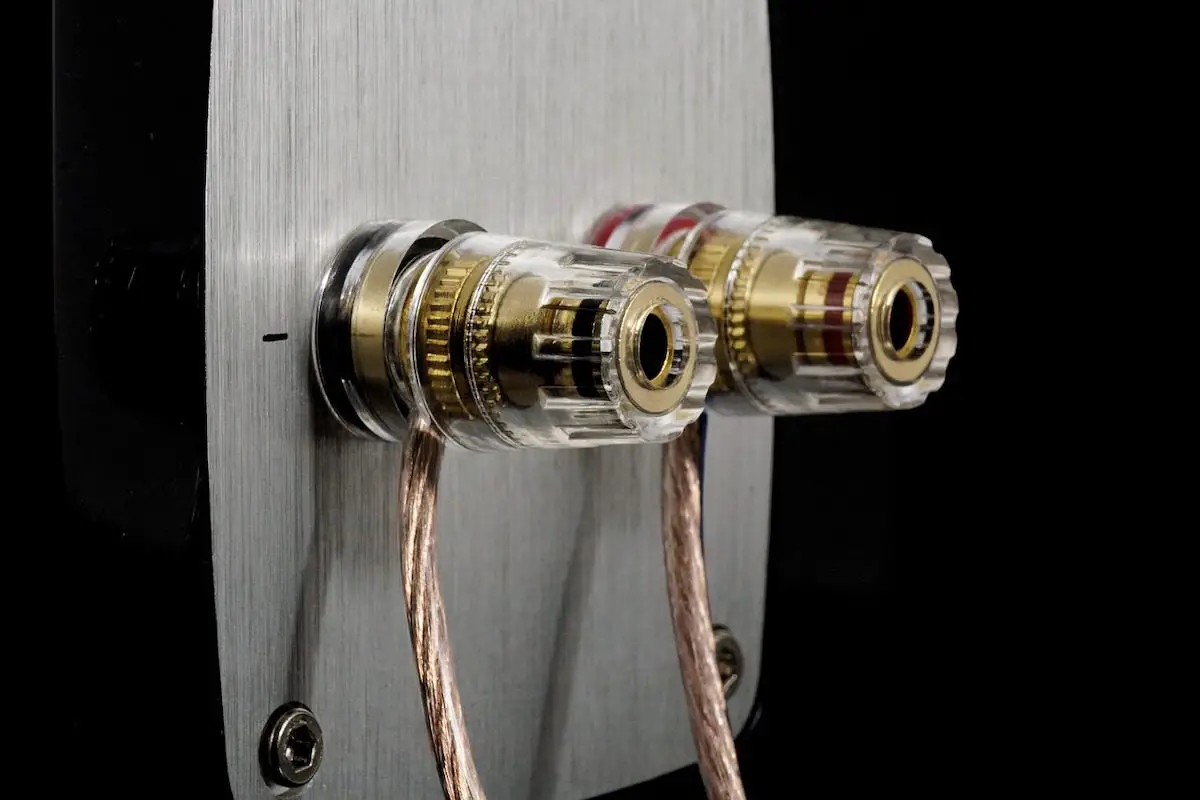Do you often find yourself wondering which speaker cable wire is positive and which is negative? If so, you’re not alone. No matter how experienced you are with audio, it’s easy to get confused by all the different speaker cables on the market.
This article covers the difference between positive and negative speaker cable wires and how to use them correctly. So if you’re always getting confused about speaker cable wires, this post is for you!
Which speaker cable wire is positive and which is negative? The positive terminal is typically located on the left, while the negative terminal is on the right. In most cases, the positive speaker wire will be a distinct color from the rest.
What are speaker cable wires?
Speaker cable wires are electrical wires used for connecting speakers to an amplifier or audio source. These wires are designed to carry the audio signal from the source to the speaker with minimal distortion or loss of signal quality. Speaker cable wires have three important electrical properties: resistance, capacitance, and inductance.

The resistance of the speaker cable wire is the most crucial property to consider when selecting a speaker wire. Low-resistance wires allow more power to flow from the amplifier to the speaker, resulting in better sound quality. Capacitance and inductance are the other two properties to consider, but they have a much smaller effect on sound quality compared to resistance.
Speaker cable wires are typically classified by their wire gauge or thickness. Thicker wires (12 or 14 gauge) are recommended for long wire runs, high-power applications, and low-impedance speakers (4 or 6 ohms). For relatively short runs (less than 50 feet) to 8-ohm speakers, a 16 gauge wire is usually sufficient.
The voltage (in volts) of the signals carried by speaker cables varies a lot from one speaker to the next. This is because smaller speakers can only take a few volts of signal, whereas larger loudspeakers and subwoofers can handle hundreds.
Both a speaker’s positive and negative terminals will take in the identical mono signal but in opposite polarity.
There is a disconnect between the speakers due to the excessive signal levels (and low noise level). This means there are two individual wires (called conductors) within the cable. The signal travels via one wire, while the ground is given by the other. Because each speaker transducer only has one ear, the resulting sound is mono rather than stereo.
Both a speaker’s positive and negative terminals will take in the identical mono signal but in opposite polarity. The positive connector in this configuration is connected to the positive signal line (the mono-unbalanced signal has positive polarity). The negative end it’s connected to the signal ground wire (the mono-unbalanced signal has negative polarity).
AKAI Professional MPK Mini MK3

AKAI Professional MPK Mini MK3
How do you know which speaker cable wires are positive and negative?
Maybe you’re wondering: “How can you tell the difference between the positive and negative speaker wire stripes?” Polarity testers can simplify your life. This helpful device is sold at most computer and electronics retailers. This check is critical for identifying the polarity of a speaker wire. The speaker’s power line will likewise be labeled in this manner.
It would help if you attempted to identify an old AA battery’s positive and negative wires. Put the woofer close to the battery to test this theory. If the positive wire retracts and contacts the negative battery terminal, it is the latter. You need to establish the proper connection if it springs back at you. Before plugging it into your amplifier, ensure you know which wire goes where.
In most cases, the back or package will indicate which speaker cables are positive and which are negative. The positive terminal is located on the left, while the negative terminal is on the right. In most cases, the positive speaker wire will be a distinct color from the rest.
This table provides a comparison between positive and negative speaker cable wires in terms of their physical characteristics and electrical properties. It is important to properly identify which wire is positive and which is negative when setting up a speaker system to ensure optimal sound quality and prevent potential damage to equipment.
| Property | Positive Wire | Negative Wire |
|---|---|---|
| Color | Usually red or marked with a “+” sign | Usually black or marked with a “-” sign |
| Material | Copper or silver-plated copper | Copper or silver-plated copper |
| Diameter | Typically thicker than negative wire | Typically thinner than positive wire |
| Direction | Connected to the positive terminal of the amplifier and speaker | Connected to the negative terminal of the amplifier and speaker |
| Polarity | Connected to the positive terminal of amplifier and speaker | Current flows from the speaker to the amplifier |
| Sound Quality | Provides better sound quality | Can cause distortion if not connected properly |
Refer to the owner’s handbook for your speakers if you need clarification about how to hook them up. It is common for speaker wire to be either red, black, or transparent. If you are unclear about which wire, use the color code to help you out.
What happens if you cross positive and negative speaker wires?
There is always a risk of confusing the positive and negative speaker cables since the wires might be hard to tell apart. But this situation is much less dangerous than when electrical lines are crossed. The speaker wires crossing won’t put you in immediate danger, so you may relax. The speaker and amplifier will be safe from harm even if the cables are accidentally switched.
A short is a cause for alarm if working with wires. However, this should not be a worry when working with speakers. Instead, you’ll hear diminished audio quality from the speakers. Also, if the cables are all tangled up, the power might not work right, or the speakers might not do what you expect.
If your speakers are acting up, one of the first things to check is the cables’ polarity to ensure the signals are being sent in the correct direction. If your speaker system isn’t working properly, this fast and easy repair may be needed to get it back up and running. Unfortunately, speaker polarity reversal is a frequent problem, but it doesn’t have to be a major concern if you know what to look for.

How do you know if the wires are properly installed?
If you want to be sure your speaker wiring is set up properly, look for these indicators.
1. Check the color-coding
Speaker cables are often color-coded, so you can easily identify the positive and negative connections. For example, red is often used to represent a positive value, whereas black represents a negative one.
2. Listen to the audio quality
How is the audio quality while playing music via your speakers? There is a strong probability that the cables are jumbled if you experience interruptions, interference, or level changes in your audio.
3. Consult the manual
If you want to ensure your speakers’ wiring is hooked up properly, you can consult the instructions for your speakers.
4. Look for physical or visual differences
Attempt to distinguish the two wires visually or by their physical characteristics. This way, you can distinguish between the wires and ensure they are connected properly.
5. Use a multimeter
Speaker polarity may be checked using a multimeter or a 9-volt battery. Using either of these two tools, you can find out which wire is negative and which is positive.
If you want even more tips and insights, watch the video “POSITIVE VS NEGATIVE: Does Speaker Wiring Matter?” from the Audio University YouTube channel.
Frequently asked questions (FAQ)
Do you still have questions about which speaker cable is positive and which is negative? Below are some of the most commonly asked questions.
How do I know which cable is positive?
As a rule of thumb, the positive wire (sometimes known as the “hot” wire) will be colored red. This is because it’s where the power comes from. As the positive wire carries electricity away from the outlet or other power source, it must always be treated as though it were live and hazardous.
Does it matter which way I connect the speaker cable wires?
Yes, it does matter which way you connect the speaker cable wires. When connecting speakers to an amplifier or receiver, it is important to connect the positive (+) and negative (-) terminals correctly. If the connections are reversed, the speakers will be out of phase and the sound quality will be adversely affected.
Can I use any speaker cable wire for my speakers?
No, not all speaker cables are created equal. The cable you choose to use can have an impact on the quality of sound you hear from your speakers. Speaker cables come in different gauges, lengths, and materials, and these factors can affect the resistance, capacitance, and inductance of the cable. These electrical properties can impact the amount of power that reaches your speakers, which can affect the clarity and fidelity of the sound. It’s important to choose a cable that is suitable for your specific setup and equipment. Factors such as the length of the cable, the power output of your amplifier, and the impedance of your speakers should be taken into account when choosing a speaker cable.
Conclusion
Well, that’s all, folks! As you can see, positive and negative speaker cable wires have different roles. Therefore, their application is also different. So, when you are about to connect your device with speakers, check the wire color of the speaker cab before connecting it.
So, do you still get confused between positive and negative cable wires? And did I cover everything you wanted to know? Let me know in the comments section below (I read and reply to every comment). If you found this article helpful, share it with a friend, and check out my full blog for more tips and tricks on music production. Thanks for reading, and never stop making music.
Key takeaways
This article covered which speaker cable wire is positive or negative. Here are some key takeaways:
- There is a large disparity between speakers regarding the voltage (in volts) of the signals conveyed by speaker cables.
- There is always a risk of confusing the positive and negative speaker cables since the wires might be hard to tell apart.
- Positive and negative speaker wires are usually distinguished by their color, material, and diameter.
- If you switched positive and negative speaker wires, you may hear reduced audio quality from your speakers or no sound at all.
- You can use a multimeter or a 9-volt battery to check for speaker polarity.















